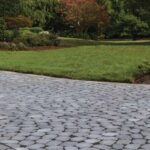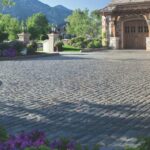Paver Design Options
Choosing Your Paving Color
Your paver colors should harmonize with the tones of your home environment, which is why we offer many paver color options. You can avoid monotony by combining colors, or by using blended hues to provide a little character to your driveway, walkway, or patio paver design. Remember, not everything needs to match perfectly. Hardscape colors should complement your home and tie the entire space together. Understanding your vision before you start your outdoor project is crucial in choosing paver colors. This will help you and us to match tones with intent.
1. Decide between Dark or Light
We recommend choosing paver colors with similar tones for a coordinated effect. Lighter colors reflect light better and open up your space, while darker tones absorb light to create the opposite effect.
2. Consider the benefits of blending
A multi-color blend combines two or more colors in a single paver. They're perfect for building a new space into an environment, and for camouflaging minor stains that can happen over time.
3. Work with the sun
When designing your hardscape project, it's important to consider where the sun hits and for how long. Colors can shift over time depending on the strength of the sunlight.
How to choose shapes and patterns
Natural, Classic and Transitional paver styles give you the freedom to realize your vision in a variety of ways. From dynamic masterpieces to simple projects—anything is possible with the right paver and a little planning.
1. Patterns Based on Architecture
Looking to match the architectural qualities of your home? Whether its a paver driveway design or patio, here are a few considerations:
-
For homes with straight lines, geometric pavers in simple patterns will complement them nicely.
-
For ornate Victorian-style homes, echo the arched windows and doors with your paver patterns.
-
For rectangular Colonial homes, repeat the look by using brick-shaped pavers
2. HARDSCAPE DESIGN PATTERNS BASED ON PAVER SHAPE
Have a specific look you'd like to accomplish with pavers? Here are a few suggestions:
-
To help narrow areas like walkways appear wider, consider laying pavers in diagonal or horizontal rows.
-
Help larger areas feel tight and unified by using grids of rectangular pavers.
-
Pavers can also be arranged so the pattern is barely visible, for a truly random feel
3. PRODUCT SELECTION
- Before falling in love with the style or color of a particular hardscape product, first consider the architectural style of your home, the surrounding landscape, and the size and function of the future hardscaped area.
4. BRING THE INSIDE OUT
- The driving trend in modern outdoor living design is to create a continuation of the indoor living environment. For the best outcome, choose styles that complement both the interior and the exterior of your home so that everything works together as one continuous, flowing design.












